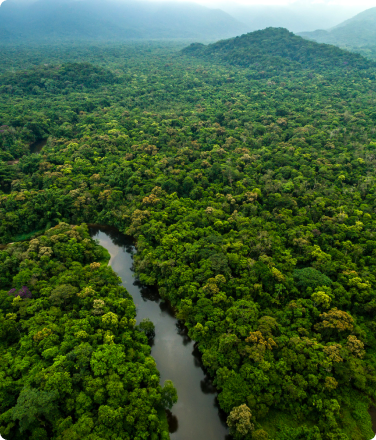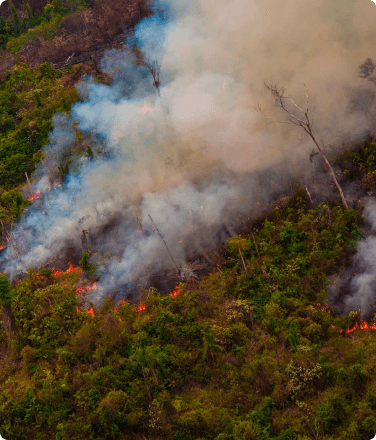Fires in Jamanxim National Forest, Brazil
The fires raging across the Amazon have largely fallen under the radar in 2020 relative to those that captured the world’s attention in 2019, despite being just as devastating if not worse. Blame the ongoing pandemic, looming elections, and extreme wildfires here at home for the distraction.
But the Amazon fires are not going away. As one fire season winds down, another begins anew. These fires persist at a great cost to the climate, global health, and indigenous peoples on the frontlines of forest protection.
What the Data Tells Us
As it has been widely reported, fires across the Amazon basin often follow deforestation, as farmers and ranchers encroach on new lands, often illegally, and burn the felled trees to make way for new, large-scale pastures and croplands.
This year, the outbreak of the COVID-19 pandemic appeared to intensify deforestation as illegal miners, loggers, and coca growers increased operations as the attention of environmental enforcement agents was redirected to national health emergency responses.
Our spatial analysis of precipitation and fire patterns across the Amazon demonstrates the cyclical relationship between dry seasons and fire. Fires in the northern Amazon begin in February and reach their peak in March, while fires in the southern Amazon begin in July and peak in August and September. This cyclical pattern corresponds primarily with the seasons as rainfall patterns oscillate across the region, creating wet and dry seasons. In the northern Amazon and Guiana Shield region, the dry season typically extends from November to May, while the southern dry season is more pronounced and lasts from May to November.
Figure 1. Cycles of fires and precipitation across the Amazon basin in 2019: Fires are constantly present across the Amazon basin, migrating in tandem with deforestation and shifting dry seasons – roughly, November through May in the north and May through November in the south. Data source: NASA
JANUARY
FEBRUARY
MARCH
April
May
JUNE
JULY
AUGUST
September
October
NOVEMBER
december
Fragmentation, Drying, Fire
Historically, rainforests have been too humid to burn oppressively hot and spread over great distances. Isolated fires that had been set to help clear land burned at low temperatures and extinguished themselves or could be readily extinguished at prescribed fire breaks.
But climate conditions across the Amazon are changing. Temperatures across the Amazon basin have risen by approximately 0.7 degrees Celsius (1.26 degrees Fahrenheit) since 1980. Over the past four decades, the Amazon’s wet areas have grown wetter while its dry areas have become drier. For example, the southern Amazon is becoming significantly drier than it once was, likely contributing to the wide-scale fires seen across Brazil’s Pantanal wetlands this year. Scientists expect that drying may further decrease the region’s humidity, bringing about the feared “tipping point” whereby rainforest landscapes gradually transform into savannah.
Fires Negatively Impact Global Climate and Health
New findings suggest that the south-eastern Amazon – roughly 20% of the entire Amazon rainforest – now releases more carbon than it absorbs. As trees succumb to deforestation, drying, and fire, their stored carbon is released into the air as carbon dioxide. Overall, researchers believe that the Amazon may absorb just half of the carbon dioxide than it did 40 years ago, going to show how deforestation and fire is fueling a climate crisis of global proportions.
Meanwhile, it has been seen that the pollution arising from forest fires in the Amazon are exacerbating diseases of the human respiratory system. Before COVID-19 erupted, a study from the Brazilian Institute for Health Policy Studies (Instituto de Estudos para Políticas, or IEPS) showed that hospitalizations in 2019 due to respiratory diseases linked to the increase in ambient air pollution from deforestation-related fires increased by 65% between July and August, the month when the fires peaked. Reporting this year indicates that fire-related air pollution is exacerbating symptoms and risk of death from COVID-19 due to increased stress on the lungs and overall health.
Indigenous Peoples’ Traditional Fire Management
For years, indigenous peoples have used the changing seasons to their advantage as they managed lands with fire for small-scale swidden agriculture and to keep forest ecosystems thriving. But as climate change has intensified dry seasons, communities like those in the Xingu (the people who motivated the founding of the Rainforest Foundation in the 1980’s), have taken to conducting their burning at the end of the rainy season, to apply fire when the foliage is wet enough to burn in a controlled manner. Conventional cattle ranching and industrial agriculture operations, on the other hand, conduct their burning at the height of the dry season, when the vegetation is at its driest and easiest to burn. This practice, however, often results in downed vegetation burning hotter and an increased chance of that vegetation burning out of control.
Figure 2. Mapping fires on and outside indigenous peoples’ lands in 2019 and 2020: There are fewer fire sightings per hectare on indigenous peoples’ lands (orange) versus outside indigenous peoples’ lands (red). Data source: NASA
JANUARY
FEBRUARY
MARCH
APRIL
MAY
JUNE
JULY
AUGUST
September
Figure 3. Measuring fires on and outside indigenous peoples’ lands: Fire occurrence per 100 million hectares (roughly the size of California, Nevada and Oregon combined) on and outside indigenous peoples’ territories (ITs) in 2019 and 2020, with 90% confidence. Data source: NASA

As illustrated above in both figures 2 and 3, consistently fewer fires are detectable per hectare on indigenous peoples’ territories compared to outside their lands. This is the result of many factors, including traditional fire practices, improved land management, and proactive approaches to conserving forests such as monitoring and rotational small scale agriculture.
Traditional Knowledge for a Sustainable Future
Indigenous peoples’ intimate knowledge of how fire interacts with the forest ecology and subtle changes in the climate extends well beyond the Amazon. In fact, indigenous peoples’ traditional fire practices have been recognized in recent years by scientists from Australia to the USA, who have been turning to them to improve land management practices.
As the fire seasons cycle around the Amazon, year after year, we are all affected. Increased carbon emissions continue to destabilize the climate, while fire-fueled air pollution aggravates human health, putting those affected by respiratory disease at even greater risk during the COVID-19 pandemic.
There is no easy fix to the Amazon fires. But continued international attention and pressure on Amazon country governments can help. Furthermore, we must amplify the voices of those who are most affected by rainforest fires – indigenous peoples – and who offer us time-tested models for how to use fire to sustainably manage forests.








